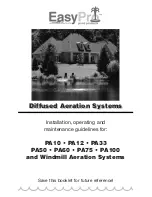
4
308270
DISPLACEMENT PUMP REPAIR
To reduce the risk of serious bodily injury, always
shut off the engine and disconnect the spark plug
before performing any checks or service.
WARNING
Disassemble the pump
1. See page 3 for how to remove the pump.
2. Use a hammer on the tabs of the lug nut (214) to
loosen the foot valve housing.
3. Disassemble the pump, but do not disassemble
the piston rod (201) from the piston housing (206)
unless one of those parts needs to be replaced.
Due to the high-strength (red) Loctite
used at the
joint of these two parts, the joint must be heated
before disassembly. Refer to Fig 4.
Clean and inspect all parts
1. Use a compatible solvent to thoroughly clean all
parts and remove all traces of sealant.
2. Inspect the parts, including the seats, for nicks and
scratches. Replace worn or damaged parts as they
cause the packings to wear more quickly and may
result in poor pump performance.
Repair Kit
A Packing Repair Kit is available. See page 6 or 7 to
order. Use all the parts in the kit for the best results.
Change the pressure drain valve u–cup packing
(included in kit) when you repack the pump.
Parts included in the kit are marked with an asterisk in
the text and drawings. For example, 208*.
Reassemble the pump
NOTE:
Refer to Fig 4.
1. If you disassembled the piston rod (201) and pis-
ton housing (206), clean the threads thoroughly.
Apply Loctite primer and then red Loctite
to the
threads and torque to 80 to 100 ft-lb (110 to
135 N.m). Allow to dry at least one hour.
2. Assemble onto the piston seat (213): washer
(212); u–cup seal (218*) with lips toward ring;
female gland (211*) and then alternate the white
(210*) and purple packings (219*), all with lips
facing up; male gland (209*).
3. Install the nut (208*) on the piston seat (213).
Hand tighten the nut very firmly.
4. Install the ball (220*) in the piston housing (206).
5. Apply blue Loctite
(supplied in kit) to the piston
seat (213) threads and screw the assembly onto
the rod, hand tight.
TIP:
Use a felt tip marker to draw a line across the
male gland, nut and piston housing to use as a visual
reference when tightening the piston and nut.
6. Place the piston seat (213) in a vise. Hold the
packing nut (208) steady with one wrench and use
a torque wrench to tighten the rod assembly to
90–125 ft-lb (122–170 N.m). Make sure the line
you made in step 5 is still aligned.
7. Grease the throat of the intake housing (227).
Assemble into the throat: male gland (204*), flat
side first; alternate white packings (225*) and
purple packings (203*) and then the female gland,
all with lips facing down. Install the packing nut
(202) and tighten firmly by hand.
8. Grease the piston packings and inside the throat
packings.
9. Grease the new o–rings (205*) and install on the
cylinder (221). Slide the cylinder into the bottom of
the intake housing (227) until you hear it snap.
10. Guide the piston rod assembly into the cylinder so
the piston rod flats are aligned with the opening in
the front of the pump. Push down until you hear
another snap. Turn the pump over and push the
assembly the rest of the way in.
11. If the rod hole is not aligned with the front of the
pump, use a screw driver through the rod hole to
turn it into place.
12. Grease the o–ring (223*), install on the plug (224),
install the plug and the screws (222) loosely.
Torque the screws to 50–70 in–lb
(5.6–8 N.m) in a crosswise pattern.
13. Install the ball (216*) and ball guide (217) into the
foot valve. Place the pump assembly on the foot
valve and push into place.
14. Screw on the lug nut (214). Use a hammer to
tighten the lug nut securely.
TIP:
The lug nut must be very tight or the pump will not
prime. Use a felt tip marker to draw a line between the
intake housing and the lug nut to use as a visual align-
ment reference during operation.
15. Install the pump and prime it. Check the packing
nut (202) and tighten it just enough to prevent
leakage.


























